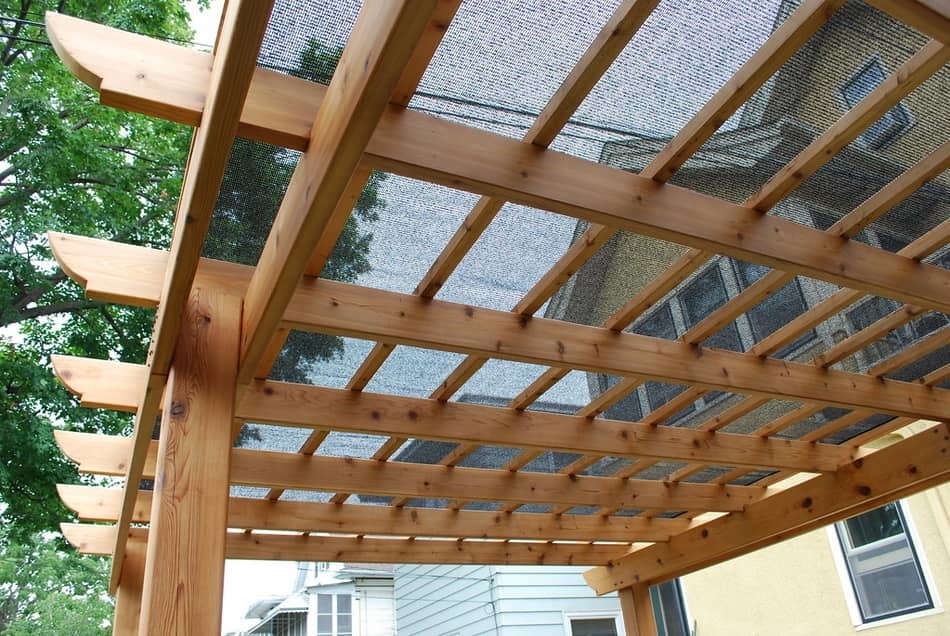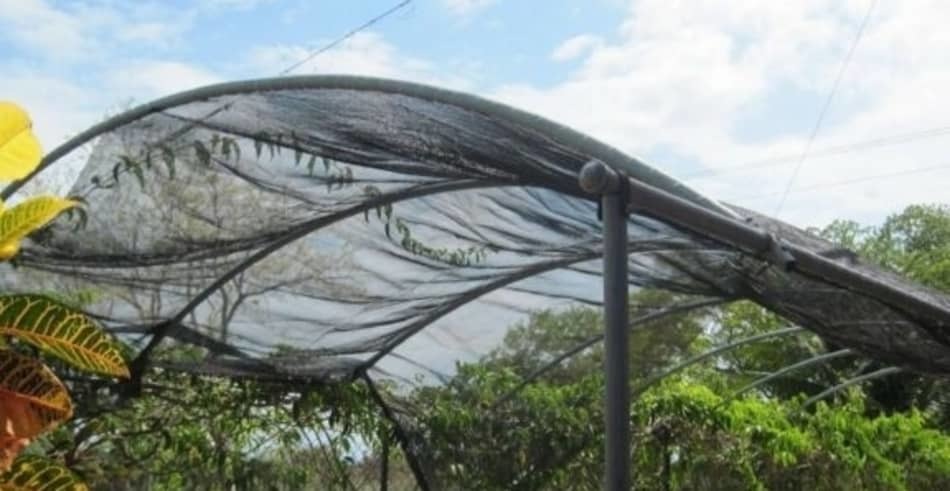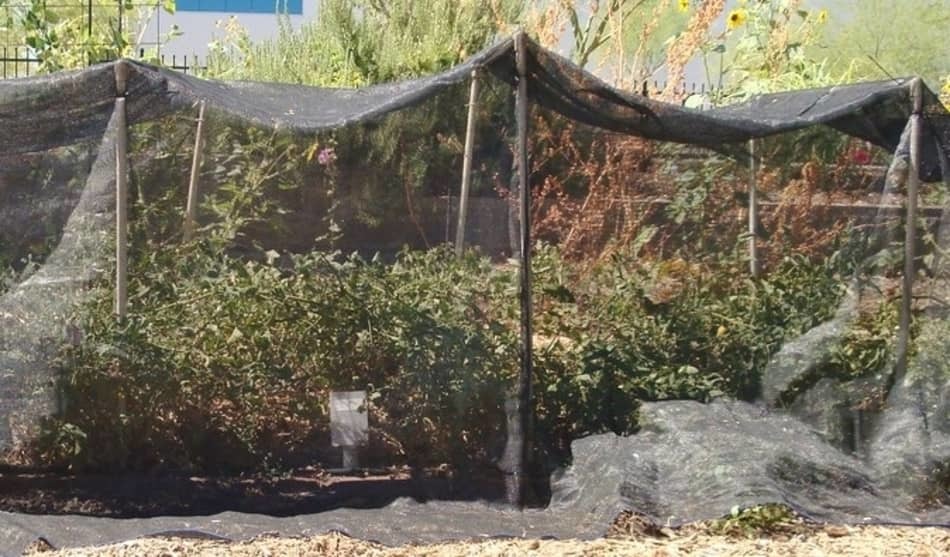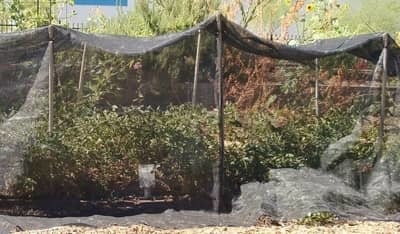Choosing the right percentage shade cloth for your garden can seem complicated. But shade cloths are actually pretty straightforward. Shade cloth percentages help you choose the cloth with the right amount of shade for what you’re growing.
Shade cloth percentage should typically be 40-60%, and can both reduce temperatures by 13 – 23 degrees F, & increase plant production. Shade-loving plants like orchids & ferns do better with a higher shading percentage (75%), & heat-tolerant plants prefer a lower percentage (30-40%).
While 40-60% is a good baseline, I do need to stop and add the disclaimer that it depends. Before choosing a shade cloth, think about what plants you are using it for. Different types of plants need different amounts of sunlight to thrive, so pick the shade cloth that’s right for what you are growing.

What is shade cloth?
Shade cloths have been around for a long time; they’re a pretty basic concept.
Shade cloths are a piece of fabric used in gardens to protect plants from too much sunlight.
Although protecting plants from too much sun is the main focus of this post, you should know that shade cloths can also be used to protect plants from cold and wind, and can be used to provide shade for animals and people.
When buying shade cloth, keep in mind that these other uses for it exist.
If you don’t want to browse through patio furniture departments or pet supplies, specify that you’re looking for garden shade cloth.
How shade cloth can INCREASE plant production
We’ve all heard of the phrase “too much of a good thing.”
When it comes to gardens, sunlight is a good thing–a critical thing!
In fact, research has shown that using shade cloth–especially during the hottest times of the year–can actually increase photosynthesis, increase crop yields, and increase the length of the growing season.
It seems counterintuitive.
But it actually makes sense, once you know the science: photosynthesis peaks within a specific temperature range–for most plants, between 50 – 68 degrees Fahrenheit.
The amount of sunlight also affects optimum photosynthesis.
So, higher temperatures and too much sun will actually decrease plant production.
Long story short: Shade cloth during the hottest, sunniest times of year will increase plant production.
Every elementary-aged kid knows that sunlight is one of a plant’s most basic needs.
Plants capture energy from the sun and turn it into sugars in the process of photosynthesis.
These sugars sustain the plants and allow them to grow.
The nutrition that we get from plants is really solar energy, combined with key nutrients, that they’ve made accessible for us.
Thank you, chlorophyll.
Bottom line, the sun is the source of all the energy that makes your garden grow.
But there is such a thing as too much sunlight. If the sun is just too strong, for too many hours a day, it can seriously damage plants.
Sunburned fruit and vegetables (yes, they can get sunburned!) can be unusable, with damaged areas marked by wrinkles and white patches.
You don’t want shriveled white raspberries or wrinkled peppers.
Luckily, it’s a lot easier to create a bit of shade than it is to conjure up some more sunshine.
Shade cloth setup: horizontal or vertical?
Most of the time, shade cloth is set up horizontally over plants, allowing enough room for proper air circulation. It can be tightly secured straight across, or domed over a garden or greenhouse.
The image that comes to your mind when you hear “shade cloth” (if any image comes to your mind at all), is probably the image of a shade cloth set up horizontally.
For me, the image that comes to mind are those tight-as-trampoline black shade cloths stretched over the tobacco fields of my home region.
Although it’s less common, shade cloth can also be set up vertically; this allows the amount of shade to change based on the time of day.
A shade cloth set up vertically would provide shade similar to the way that a tall plant in your garden would provide shade to shorter ones.
This is more difficult to set up, so when the average gardener is talking about shade cloth, they’re usually thinking a horizontal set up.

Shade cloth features
Shade cloths protect plants from sun damage, and really allow them to thrive.
You can’t just put any old thing that casts a shadow over top of your garden, however.
Besides just diminishing sunlight, shade cloth also diffuses the sun’s rays, and it has to be made of material that allows for air circulation and moisture to get through to the plants.
When buying shade cloth, there are different features to consider. Shade cloth:
- comes in different colors,
- can be woven or knitted material, and
- its density percentages can range anywhere from 10% to 90%!
Shade cloth density: choosing the right percentage
Shade cloth density refers to how much sunlight a shade cloth blocks.
The higher the percentage, the more sunlight being blocked. So, a shade cloth with 10% density is only blocking 10% of sunlight, while a shade cloth with 90% density is blocking 90% of the sunlight.
The main point of shade cloth is to provide shade, so the shade cloth density–the amount of sunlight being blocked–is really the key feature to consider.
Although “density percentage” sounds a little technical compared to color and fabric type, the shade cloth percentage is worth taking the time to understand.
Since sunlight is key to plants’ survival, getting the right percentage–essentially, providing your plants with the right amount of sunlight–is important.
Not all plants need the same amount of sun.
Even in the ultra-concise instructions that fit on the back of a seed packet, noting a plant’s sun preference–full sun or partial sun or shade–is often included.
A plant that needs lots of sun is not going to be happy under a shade cloth with 85% density, and the shade-lovers are going to get burnt under a 15% cloth.
When you get the percentage right, you’ll see a difference in your plants.
Shade-loving plants grown under shade cloth, for instance, have noticeably bigger leaves and produce more nodes.
Shade cloth percentage is what’s going to make the difference between sunburned, shriveled plants and full, lush plants.
On the flip side, if you go with a percentage that is too high, you’re going to have some sad, sun-starved members of your garden.
Bigger, healthier, and more productive plants make for happier gardeners.
Recommendations & guidelines
For most plants, 40-60% shade percentage helps dial down the sun’s intensity, but still provides enough sunlight to power the process of photosynthesis. Generally, 50% shade cloth is a safe bet; this percentage works well for a range of vegetables and flowering plants.
Only a few particularly shade-loving plants, like ferns and orchids, would require a higher shade percentage.
If you want to buy a shade cloth to be used for one specific type of plant (as opposed to a mixed garden), you might want to break it down even further and follow these guidelines:
|
Shade Cloth % |
Recommended Use |
|---|---|
|
30% |
for more heat tolerant plants such as tomatoes, cucumbers, watermelon, strawberries and peppers. |
|
40-50% |
for flowering plants. Most fruits and vegetables are happy in this range. |
|
60% |
for plants that are more sensitive to sunlight, like lettuce,greens, and spinach. Some herbs do well here, too, like dill, parsley and cilantro. |
|
75% |
plants, like ferns & orchids. also useful to provide shade for people or animals. |
Happy shade cloth shopping!
Hopefully you now have a better idea of what kind of shade cloth will meet your needs (most importantly–your plants’ needs!).
Although it sounds like a nitpicky gardening term at first, shade cloth density is really a simple concept that can yield great results.
Getting the right shade cloth density percentage will let you tweak the amount of sunlight added to your garden, a most important ingredient for success!

Related Questions
What color shade cloth should I use?
Different colors of shade cloth can reflect or absorb sunlight differently. For general gardening use, green or black are the most common colors.
White, tan or red are also available.
Some shade cloths have aluminum woven into the fabric to reflect UV light, and this makes a greater difference than the color itself.
Knitted vs. woven shade cloth?
It depends—but for most gardens, knitted is the way to go.
Knitted shade cloth allows for more ventilation (less heat buildup) for plants, won’t fray and unravel if cut, is easier to install, and resists horticultural chemicals.
Woven shade cloth is heavier and doesn’t last as long, but can also be used as a wind screen, privacy screen or shade for people/animals.
What is GSM in shade cloth?
GSM refers to “grams per square meter” and describes the weight of the cloth.
The higher the GSM, the thicker the material. While this isn’t the only factor, a higher GSM generally means a higher the shade rating.
What is the best shade cloth for plants?
Well, that depends on which plants, of course.
For most gardens, the best shade cloth for plants would be a green knitted shade cloth in the 40-60% density range.


